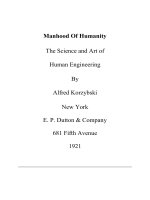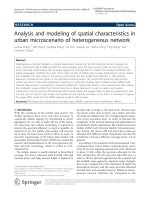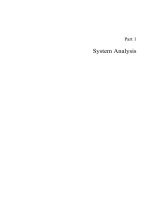Analysis and detection of human motion in time frequency domain
Bạn đang xem bản rút gọn của tài liệu. Xem và tải ngay bản đầy đủ của tài liệu tại đây (6.75 MB, 167 trang )
ANALYSIS AND DETECTION OF HUMAN MOTION IN
TIME-FREQUENCY DOMAIN
NYAN MYO NAING
B.E (ELECTRONICS)
YANGON TECHNOLOGICAL UNIVERSITY
YANGON, MYANMAR
A THESIS SUBMITTED
FOR THE DEGREE OF DOCTOR OF PHILOSOPHY
DEPARTMENT OF MECHANICAL ENGINEERING
NATIONAL UNIVERSITY OF SINGAPORE
2006
2
Acknowledgements
I wish to express my sincere appreciation and gratitude to my supervisors, Dr.
Tay Eng Hock, Francis and Dr. Seah Kar Heng for their encouragement, valuable
suggestions, and guidance without which the research could have not been finished.
I owe my thanks to Dr Yih Yiow Sitoh and Dr Noor Hafizah B Ismail from Tan
Tock Seng Hospital, for their help and assistance. Thanks are also given to staffs from the
Department of Geriatric Medicine, Tan Tock Seng Hospital, for their help during the
experiment.
I would like to thank my friends, Mr. Nay Lin Tun and Mr. Pyi Soe, and other
friends who helped me throughout the research.
Special thanks must go to my mother for her support, and encouragement during
my PhD candidature.
3
Table of Contents
Acknowledgements 2
Table of Contents 3
Summary 7
List of Symbols 9
List of Figures 11
List of Tables 16
1 Introduction 17
1.1 Background………………………………………………………………… 17
1.2 Objectives…………………………….…………………………………… 19
1.3 Outline of the thesis……………………………………………………… …20
2 Literature review 21
2.1 Studies on previous activities of daily living (ADL) detection methods…… 21
2.2 Falls among the elderly and previous elderly fall detection methods…………28
2.3 Review of previous falls and ADL detection research works……… ……….35
2.4 Activities of daily living (ADL) detection and time-frequency analysis…… 37
3 Multiresolution analysis and wavelets 39
3.1 Wavelet transform: Continuous and discrete 39
3.1.1 Continuous wavelet transform (CWT)………… …………………… 39
3.1.2 Discrete wavelet transform (DWT)…………….………… ………….41
3.2 Multiresolution approximations of closed subspaces……….…………… 43
4
3.3 Orthogonal wavelet functions and detail spaces…………… …………… 46
3.4 Practical implementations of discrete wavelet transform
and multiresolution analysis ……………………………………………….49
3.5 Discrete dyadic wavelet decomposition…………………….………… … 51
3.6 Discussion on application of wavelet analysis…………………………… 53
4 Wavelet analysis for Activities of Daily Living (ADL) 58
detection
4.1 Development of Wearable Micro-Electro-Mechanical
System (MEMSWear)………………………………………………………58
4.2 Validation of acceleration signals using motion analysis system
(Vicon
TM
)……………………………………….………………………….60
4.2.1 Experimental procedure for validation of accelerometers… 62
4.2.1.1 Experiment done on a rigid rod……………………… 63
4.2.1.2 Experiment done on the human subject…….……………… 64
4.3 ADL detection in time-frequency domain…………………………….……67
4.3.1 Lie-sit/sit-lie transition detection……………………………… 67
4.3.2 Sit-stand/stand-sit transitions detection………………………… 69
4.3.2.1 Subjects and experimental procedure …………………… …70
4.3.2.2 Detection methodology ……………………………………….71
4.3.2.3 Results ……………………………………………… ………75
4.3.2.4 Discussion ……………………………………………… … 80
4.3.3 Human motion activities detection………………………… 84
4.3.3.1 Subjects and experimental procedure …………….………… 84
5
4.3.3.2 Detection methodology……………………….…….…………85
4.3.3.3 Experimental results…………………………… ….…………92
4.3.3.4 Discussion …………………………………………………….96
4.3.3.5 Accuracy improvement using new features
in human motion patterns classification… ………………… 99
4.3.3.6 Experimental results ……………………………….…….… 101
4.3.3.7 Discussion ……………………………………… …………105
5 Detection of falls: post impact and pre-impact 107
5.1 Fall detection and fall incident notification ……………………………… 107
5.1.1 Methodology…………………………………………………….……107
5.1.2 Subjects and experimental procedure……….…………….… 109
5.1.3 Discussion …………………………………………… ………… 110
5.1.4 A smart device that can call for help after a fall………… … 114
5.2 Pre-impact fall detection…………………………………… ……….116
5.2.1 Distinguishing fall activities from normal activities by angular
rate characteristics and high speed camera characterization…… … 116
5.2.2 Materials and methods……………………….…………….…………117
5.2.3 Results ………….….…………………………………………… ….121
5.2.4 Discussion ……….…………………………………………… ……128
6 Real-time detection of falls and ADL using wearable 134
computing platform
6.1 Methodology ………………………… ………………………………… 134
6.2 Subjects and experimental procedure……….…………………………… 138
6
6.3 Results ………………………………………………………… …………140
6.4 Discussion ………………………………………………… …………… 141
7 Conclusions and recommendations 145
References 150
Author’s Publications 164
Appendix A 166
7
Summary
Falls and activities of daily living (ADL) detection in humans require an objective
and reliable technique to be used under free-living conditions. The emphasis of this study
is to develop a wearable fall and ADL detection system that can detect a broad range of
ADL using relatively fewer sensors, in comparison to other researchers’ systems, for the
comfort of the user in long term application. The system can also raise fall notifications
without user intervention to get a shortened interval before the arrival of assistance.
To provide long term comfort for the wearer, we use a garment as a wearable
platform. A triaxial accelerometer measuring in lateral, antero-posterior and vertical
directions is attached at the shoulder position of the garment. ADL detected in our studies
are vital daily activities such as sitting, standing, lying down, lying to sitting, level
walking, ascending stairs and descending stairs. However, in sitting, standing, and lying
down detection, instead of detecting static postures, we detect stand-sit/sit-stand, and lie-
sit/sit-lie posture transition activities.
In fall detection, we have developed a fall notification system that can summon
medical assistances via SMS (Short Messaging Service). This is the detection system as
perfect in its kinds as that which can detect fall with no detection range limitation and can
raise fall alarm (fall SMS) on its own to individuals and health care unit to shorten the
interval of the arrival of assistance. A new method of time-frequency based ADL
detection using two acceleration signals, vertical acceleration signal and antero-posterior
acceleration signal, from the accelerometer attached onto the shoulder part of a garment
is proposed. Real-time wearable falls and ADL detection system is implemented and
8
normal healthy three male and three female subjects involved in approximately five-hour-
long experiment. Overall sensitivity (defined as the ability of the system that can
correctly detect the activities) 94.98 per cent and specificity (defined as the ability of the
system that generates no false detection) 98.83 per cent were achieved.
We have also explored the possibility of pre-impact fall detection that is
distinguishing sideways and backward falls, which can cause hip fractures among the
elderly, from ADL using angular rate sensors (gyroscopes). The purpose of this study is
to investigate a method for the automatic detection of fall, which can cause hip fractures,
during its descending phase before the subject hits the floor so that this favorable method
can be used to develop a fall injury minimization system for the elderly.
In conclusion, our experimental results show that a new wearable detection system
by securing a miniature triaxial accelerometer on a garment allows detection of falls and
a broad range of ADL, in comparison to other researchers’ systems, in high accuracy.
Moreover, the method of fall pre-impact detection can also be used to complement an
injury minimization system such as an inflatable hip protection device to be activated
upon imminent fall.
9
List of Symbols
)(t
ψ
Continuous-time wavelet function
( )
t
φ
Continuous-time scaling function
( )
ω
Ψ
Fourier transform of )(t
ψ
( )
ω
Φ
Fourier transform of
( )
t
φ
a Dilation parameter in wavelet transformation
b Location or translation parameter in wavelet transformation
R
The set of real values
Z
The set of integer values
( )
2
L
R
Space of square-integrable functions
( )
2
l
Z
Space of square-summable sequences
( )
f t
Square integrable function
)(
,
t
ba
ψ
Complex conjugation of
)(
,
t
ba
ψ
.
),( ba
f
W
Continuous wavelet transform(CWT)
N Number of coefficients
J Maximum scale of DWT decomposition
j Decomposition level
V
Vector of wavelet coefficients at scale maximum scale M
W
Vector of coefficients at each scale of decomposition
S
Reconstructed approximation signal
D
Reconstructed detail signal
10
Approximation vector space
Orthogonal complement of
g
Impulse response of scaling filter
h Impulse response of wavelet filter
( )
H
ω
The absolute value of transfer function of
{ }
h
n
( )
G
ω
The absolute value of transfer function of
{ }
g
n
11
List of Figures
2.1 Acceleration signals during level walking, sit-stand/stand-sit 38
transitions and lie-sit/sit-lie transitions.
3.1 Discrete wavelet transform 50
3.2 Wavelet reconstruction (a) detail signal (b) approximation signal 51
3.3 Discrete dyadic wavelet decomposition 53
3.4 Detail and approximation signals of DWT decomposition 54
3.5 Original signal and its extracted signal component using MRA 55
4.1 Experimental setup 59
4.2 Front and rear views of markers on the subjects 60
4.3 Schematic Layout of the Laboratory (Top View) 61
4.4 Movement direction of the rigid rod and the axis of 62
the Vicon
TM
system (Top View)
4.5 Graph of Acceleration (m/square sec) Vs Time (second) 63
for the comparison done on a rigid rod
4.6 Comparison of accelerometer readings and Vicon
TM
65,66
system readings for accelerometers and a marker at right
shoulder position (a) level walking, (b) sit-stand/stand-sit
transition activities, and (c) sit-lie/lie-sit transition activities
4.7 Vertical acceleration signal and its reconstructed signal 68
used in lie-sit/sit-lie transition detection
4.8 Vertical acceleration signals and their reconstructed 68,69
signals (<1Hz) for falls and ADL
12
4.9 Activities related to test number 3 shown in Table 4.1 71
4.10 Antero-posterior and its reconstructed acceleration signal 72
4.11 Vertical acceleration signals, antero-posterior acceleration 74
signals and reconstructed antero-posterior acceleration
signals for (a) test number 1 and (b) test number 2, test
number are shown in Table 4.1
4.12 Extracted vertical acceleration signals for sit-stand and 76
stand-sit transition activities
4.13 Vertical, antero-posterior and reconstructed antero-posterior 76
acceleration signals for test number 4
4.14 Feature vectors used in sit-stand and stand-sit transition activity 80
classification
4.15 Antero-posterior acceleration signal and its reconstructed 81
signal for test number 1
4.16(a) The square of vertical acceleration signal is decomposed 86
into six scales through the dyadic wavelet transform
4.16(b) The antero-posterior acceleration signal is decomposed 86
into eight scales through the dyadic wavelet transform
4.17 Decomposed signals of square of vertical acceleration 88
signal and their correlated signal after rescaling process
4.18 Human motion patterns classification flow chart (i) 91
4.19 The acceleration signals, extracted coefficients and 93
separated segments of human motion patterns in
13
the acceleration signals
4.20 44 pairs of P
a
and P
v
for ascending and descending stairs 96
and 66 pairs of P
a
and P
v
for level walking from 22 subjects
and their relationship in classification
4.21 Human motion patterns classification flow chart (ii) 99
4.22 Level walking activity and its separated segments 102
4.23 PcoefsY
and PcoefsZ
of level walking, ascending stairs 103
and descending stairs activities
4.24 Magnified plot showing relationships between PcoefsY
104
and PcoefsZ for level walking segments of Figure 3.a (134 out of
215 points of (PcoefsY
, PcoefsZ) are zero and subplots are
magnified version for the interval 0-0.001 of PcoefsY axis)
4.25 During ascending stairs, the body posture is forward 104
tilting and prone position. Because of the changes
in accelerometer response due to gravity, the low frequency
component represents negative g values in ascending
stairs portion of antero-posterior acceleration signal
5.1 Fall detection system 108
5.2 Fall simulator 110
5.3 Three dimensional acceleration signals for (a) test number 1, 111,112
(b) test number 2, and (c) test number 4, shown in Table 5.1.
5.4 Distribution of summation of absolute peak values for 113
normal activities and fall activities for 10subjects
14
5.5 Modified fall detection system 115
5.6 Real-time fall notification system 115
5.7 Angle of body configuration at the threshold level 117
5.8 Experimental set-up of pneumatically-actuated fall 118
simulator for back slip
5.9 Orientation of the gyroscopes incorporated (a) and 119
MEMSWear with real-time data acquisition (b)
5.10 Normal activities from the sensor at position RU (a=standing 121
up, b= walking straight, c= bending down to pick up a pen
on the floor, d=sitting down onto a bed, e=lying down on
the bed, and f= posture transition from lying to sitting on the bed)
5.11 The mean and one side standard deviation of positive peak 122-124
and negative peak angular rates of gyroscope sensors at position FW,
S and RU. Both positive and negative peak angular rates of fall
activities are significantly higher than those of the normal
activities (p < 0.0001)
5.12 The mean and one side standard deviation of lead time for fall 125
activities (20 trials for each fall activity) (1 = left hand side fall
(FW), 2 = left hand side fall (S), 3 = right hand side fall (FW),
4 = right hand side fall (S), and 5 = backward fall (RU))
5.13 Sensor signals showing the lead times for sideways falls (left hand 126
side and right hand side) and backward fall
5.14 Typical body configuration at threshold level for backward 127
15
fall and sideways fall
5.15 The mean and one side standard deviation of the body 127
configuration at threshold level (20 trials for each fall activity)
(1 = left hand side fall (FW), 2 = left hand side fall (S), 3 = right
hand side fall (FW), 4 = right hand side fall (S), and
5= backward fall (RU))
5.16 The angular rate of right hand side fall from the sensor at 129
position FW and position S
5.17 Picture frames related to knee hit and hip hit (end of the fall) 131
6.1 Wearable real-time falls and activities detection system 135
6.2 The process of data collection and data processing for falls 136
and ADL detection
6.3 Falls and ADL detection algorithm flow chart 137,138
6.4 Two different experimental settings 139
A.1 The schematic layout of the accelerometer at different 167
Orientations with the corresponding DC component values
16
List of Tables
2.1
Literature review of previous researchers' work in falls and ADL 36
detection
3.1
The frequency bandwidths of decomposed signals at different scale 52
m decomposition
4.1 Type of activities performed by each subject 70
4.2 Error, sensitivity, specificity of separated segments and comparison of 78,79
start/end time of segments observed in the video clips and extracted
by the algorithm
4.3 Segments of human motion activities separation algorithm 89
4.4
Error, sensitivity, specificity of separated stairs segments and comparison 95
of start/end time of segments observed in the video clips and extracted by
the algorithm in human motion patterns classification
4.5 Number of separated segments for level walking, ascending stairs 100
and descending stairs
4.6 Number of segments with positive, negative and no extracted coefficients 101
after applying the separation algorithm
5.1 Types of activities performed by each subject 109
5.2 Estimation the performance of fall detection using angular rate sensors 128
5.3 False alarm table for normal activities (Number of false alarms) 131
6.1 The sensitivity and specificity of activities in approximately five-hour 140
long experiment
17
Chapter 1
Introduction
1.1 Background
Singapore has one of the fastest aging populations in the world, with an
anticipated increase in the proportion of older persons above 65 years of age from 7.3 per
cent in 1999 to 18.9 per cent in the year 2030 [1]. Alongside the rapid graying of the
population, the economic burden of managing multiple chronic conditions commonly
encountered in the elderly is likely to put a strain on the healthcare system, as has been
demonstrated in other developed countries [2]. Falls constitute a major healthcare
concern in older persons and can affect 30% of community dwelling older persons each
year [3]. Apart from causing physical injury, falls can result in psychological trauma and
lead to an increased risk of admission to nursing homes [4]. Studies examining injuries in
community-dwelling elderly indicate that falls are the leading cause of traumatic brain
injury (TBI) followed by motor vehicle crashes [5, 6]. Another serious major fall-related
injury is hip fracture. Twenty six percent of the elderly with hip fractures died within a
year [7]. Moreover, the consequences of falls may lead to institutionalization, restricted
activity, other minor injuries, fear of falling, or death. Therefore, prevention and
detection of falls have been an important research area since two decades ago [8-18]. In
this context, the ability to monitor different movements and postures involved in the daily
routine of older persons who are living alone may help to pave the way for identifying
persons who have fallen or are at risk of falling. Such an ability may also allow a better
18
assessment of activities of daily living (ADL) and the effects of numerous medical
conditions and treatments [19], thus paving the way for planning interventions aimed at
maintaining independence and enhancing safety of the elderly people. This surveillance
can also be the detection of long periods of inactivity in older persons who will be
spending significant portions of their daily routines alone. Moreover, the assessment or
detection of ADL is an essential issue in ambulatory monitoring because physiological
responses, such as changes in heart rate or blood pressure, may result from changes in
body position and physical activity. Besides, it is a key determinant in evaluation of the
quality of life of subjects with limited mobility, such as elderly persons [19].
Even though extensive research has been done in fall and activities of daily living
(ADL) detections, some limitations are still observed and are listed below.
(1)
There is no consideration for the comfort of the wearer in fall and ADL detection
for long term application.
(2)
All fall detection systems developed over the past two decades are with detection
range limitation.
(3)
There is no implementation of wearable real-time ADL detection system that can
be used to detect abnormal activities in real time, for example, extended walking
of an elderly, which could mean that the subject is in a state of trance, or
wandering of subjects suffering from dementia.
(4)
Fall detection and fall risk assessment, assessment of physical and mental
conditions of the elderly or environmental condition that can lead to fall incident,
have been mostly focused in elderly fall safety research and no investigation of
pre-impact fall detection is conducted using wearable sensors in distinguishing
19
fall activities from normal ADL in the earlier stage of fall before the person
touches the ground. The advantage of the investigation is that a fall injury
minimization system can be developed, for example, by incorporating the pre-
impact fall detection system with an inflatable hip protection device.
1.2 Objectives
In this thesis, a novel approach of falls and activities of daily living (ADL)
detection based on a normal garment (vest) is described. The objectives of this study are
listed below:
(1)
Develop a wearable system that can detect a broad range of ADL using relatively
fewer sensors, in comparison to other researchers’ systems, for the comfort of the
user in long term application.
(2)
Design a novel fall detection system (post impact detection) with no detection
range limitation and the system can raise fall notifications, without user
intervention, to individuals and health care unit at the same time to get a
shortened interval before the arrival of assistance.
(3)
Implement a real-time fall and ADL detection system using the methods
developed by objectives number 1 and number 2.
(4)
Investigate a method of pre-impact fall detection that can distinguish fall
activities from normal activities at the earlier stage of fall process before the
subject touches the ground.
20
1.3 Outline of the thesis
This dissertation is organized into seven chapters. In Chapter 1, the background
information and objectives of the research are explained, and then previous applications
falls and ADL detection systems are reviewed in Chapter 2. Chapter 3 illustrates the three
basic blocks of wavelet time-frequency analysis: continuous wavelet transform, discrete
wavelet transform and multiresolution analysis. A brief description of discrete dyadic
wavelet transform is also discussed. Chapter 4 describes the detection procedure of ADL
in time frequency domain. Fall detection (post impact detection) including
implementation of fall notification system and pre-impact fall detection using angular
rate sensors are discussed in Chapter 5. Chapter 6 then presents the implementation of
real-time fall (post impact detection) and ADL detection system using the methods
developed in Chapter 4 and Chapter 5. Finally, the summary of achievements and the
recommendations are presented in Chapter 7.
21
Chapter 2
Literature review
2.1 Studies on previous activities of daily living (ADL) detection methods
ADL detection research works can be separated into two groups, home-based
detection and body-worn devices. Yamaguchi et al. [20] and Noury et al. [21] have
developed indoor monitoring systems using infrared position sensors and magnetic
sensors. The sensors are located at designated locations such as furniture, doors and
corridors to monitor behaviors during daily life. Daily life behaviors and activities such
as how many hours the subject stays in bathroom, living room, and kitchen and on bed in
his/her daily life are studied. In addition to sensors mentioned above, Ogawa et al. [22]
added carbon dioxide sensor to improve the measurement accuracy of the presence of the
subject in the room. In these home-based detection methods, the sensors are fixed at
designated locations. If the subject were to venture beyond the designed sensor range, as
in the case of wandering of subjects suffering from dementia, the effectiveness of the
sensors would be compromised. It is thus more viable for the sensors to be directly
located on the subject for applications in free-living condition.
ADL detection requires an objective and reliable technique to be used under free-
living conditions. From a physiological point of view, daily activity, regarded as any
movement or posture that is produced by skeletal muscles, results in energy expenditure
[23]. The energy expenditure due to physical activity is widely accepted as the standard
reference for physical activity assessment [24], but measurement of this variable under
22
conditions of daily living is impractical and not feasible for population studies. Therefore,
interests for estimates of energy expenditure based on observations, questionnaires, heart
rate recordings, or movement registration are growing. At present, movement registration
with body-worn motion sensors offers the best alternative for ADL detection. Various
motion sensors have been designed for this purpose, ranging from mechanical
pedometers [25] and actometers [26] to accelerometers [27-29]. Accelerometers respond
to both frequency and intensity of movement, and in this way accelerometers are superior
to pedometers and actometers, which are attenuated by impact or tilt and only count body
movement if a certain threshold is passed. Due to the current state of art in integrated
circuit technology there is also good opportunity to build very small and lightweight
accelerometer systems that can be worn for days or even weeks. Moreover,
accelerometers have been used for several decades to study human motions and other
movements [30-33] and also for the measurement of tremor and motor activity in
neurological patients [34-36]. However, precise detection of ADL using accelerometer
requires classification of activities such as walking, ascending stairs, descending stairs
and lying down, etc.
In human motion activities (level walking, ascending stairs, and descending stairs)
detection, Najafi et al. [19], Bouten et al. [32], Veltink et al. [33], Foerster et al. [34],
Aminian et al. [37], Mantyjarvi et al. [38], Sekine et al. [39, 40], and Coley et al. [41]
used uniaxial or triaxial accelerometers in their detections. Najafi et al. [19] detected
ADL using a kinematic sensor, which is composed of one miniature gyroscope measuring
in sagittal plane and two miniature accelerometers measuring vertical and frontal
accelerations of the subject. The sensor was located on the subject’s chest, but no detail
23
expression is provided on how the sensor was placed on it. Level walking activity was
simply detected using a fixed threshold, no threshold value was reported, and successive
peaks with intervals of 0.25-2.25 seconds were chosen as walking steps. The detection
method is very simple and it cannot distinguish among level walking, ascending stairs
and descending stairs. Bouten et al. [32] described the development of a triaxial
accelerometer (TA) for the assessment of ADL. The TA is composed of three
orthogonally mounted uniaxial piezoresistive accelerometers and is attached to the low
back of the subjects at the level of the second lumbar vertebra by using an elastic belt
around the waist. The main objective of the research is to evaluate the relationship
between energy expenditure due to physical activity and body acceleration, the sum of
the integrals of the absolute value of accelerometer output from all three measurement
directions (IAAtot), during different types of ADL. Energy expenditure was measured
from indirect calorimetry, and sleeping metabolic rate (SMR) [32]. In this method,
IAAtot can be effectively used to evaluate the relationship between energy expenditure
and physical activities, but it cannot classify types of activities. Veltink et al. [33]
attempted to classify static activities such as sitting, standing, and lying and dynamic
activities such as cycling, level walking, ascending stairs and descending stairs, using
three uniaxial accelerometers mounted tangentially (forward) and radially (vertical) on
the mid-sternum and tangentially (perpendicular to the front thigh surface) on the upper
half of the thigh using double-sided tape. It is recommended that the tangential thigh
accelerometer can be used to distinguish among the three subgroups of dynamic
activities, (1) level walking, (2) ascending stairs and descending stairs, and (3) cycling.
The mean values of individual cycles of motion activities (walking on level ground and
24
stairs) of the thigh tangential accelerometer signals were used to distinguish level walking
from ascending stairs and descending stairs and the finding was statistically significant
among five able-bodied subjects between 23 and 42 years of age (248 times walking
through a building (distance was not shown in the paper), 40 ascending stairs and 35
descending stairs activities, sign test,
< 0.05). However, this method cannot be used to
differentiate between ascending stairs and descending stairs. Maximum correlation
coefficients between individual cycles of walking on stairs activities and reference
templates were used to distinguish between ascending stairs and descending stairs, but
the technique still resulted in poor classification rate, 17% error for ascending stairs and
20% error for descending stairs for 40 ascending stairs and 35 descending stairs activities.
Foerster et al. [34] detected ADL using four uniaxial accelerometers located at sternum,
wrist, thigh, and lower leg. The sensors were fastened with Velcro bands and the
sensitivity axis of the sensors was roughly perpendicular to the surface, i.e., to the frontal
aspect of the sternum, dorsum of the lower arm segment, frontal aspect of thigh, and
lower leg segment [34]. Twenty four male subjects, 21 to 34 years of age, were recruited
to perform standard protocols consisting of seven types of activities, sitting, standing,
lying supine, level walking, ascending stairs, descending stairs, and cycling. The recorded
acceleration signals were manually separated in length of 20 seconds time-interval for
each activity and similarity was determined by the so called L1 distances by referring to
the standard protocol variable profiles [34]. In motion activities (walking on level ground
and stairs) classification, 107 out of 121 level walking activities, 80 out of 108
descending stairs activities and only 20 out of 49 ascending stairs activities were
correctly detected. Aminian et al. [37] presented the estimation of the incline and speed
25
of walking using neural networks. Then, Mantyjarvi et al. [38] classified level walking,
ascending stairs, and descending stairs using two triaxial accelerometers. Sensors were
located at the left and right sides of the hip with belt. Six channels of acceleration signals
were processed with PCA (principal component analysis) or ICA (independent
component analysis) and then DWT (discrete wavelet transform) was applied. Powers of
wavelet coefficients of levels 5 to 8 were used as features in classification using three
multilayer perception neural networks. It is proved that applications of ICA or PCA with
wavelet transformation to six channels of acceleration signals can give better
classification rate than the original data by using three multilayer perception neural
networks. The best classification results were 83 % (ascending stairs), 84 % (descending
stairs), and 90 % (level walking) and their method gives poor classification rate for three
channels of acceleration signals. Moreover, application of neural networks needs a large
number of training patterns to reduce the error. Sekine et al. [39] studied distinguishing
walking on level ground from walking on a stairway using a triaxial accelerometer
located at waist level. Walking patterns (level walking, and walking of stairs) were
classified in two stages. In the first stage, walking patterns were separated using low-
frequency components of antero-posterior acceleration signal and vertical acceleration
signal. Low-frequency components were taken out from the original signals using MRA
(multiresolution analysis). In detection of pattern changes in separation of ascending
stairs activity from level walking activity, they manually set an individual threshold level
for each subject at the low frequency component of antero-posterior acceleration signal.
Times of pattern changes between ascending stairs and level walking were obtained from
crossing points of the threshold level and the low frequency component of the signal.









